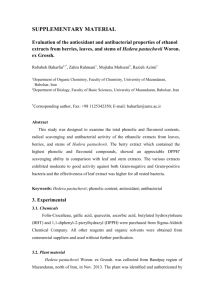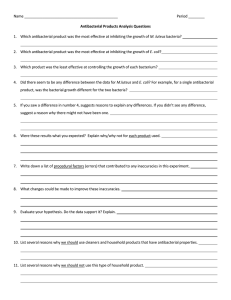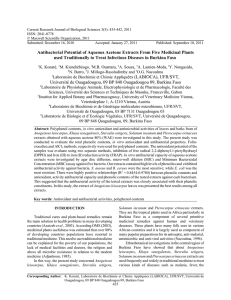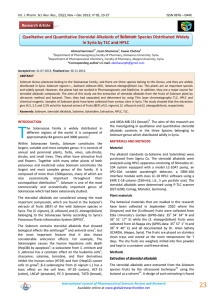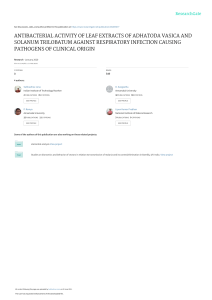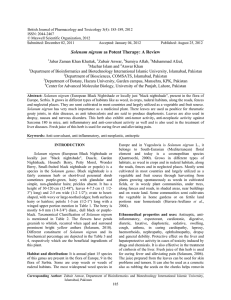Document 13309183
advertisement
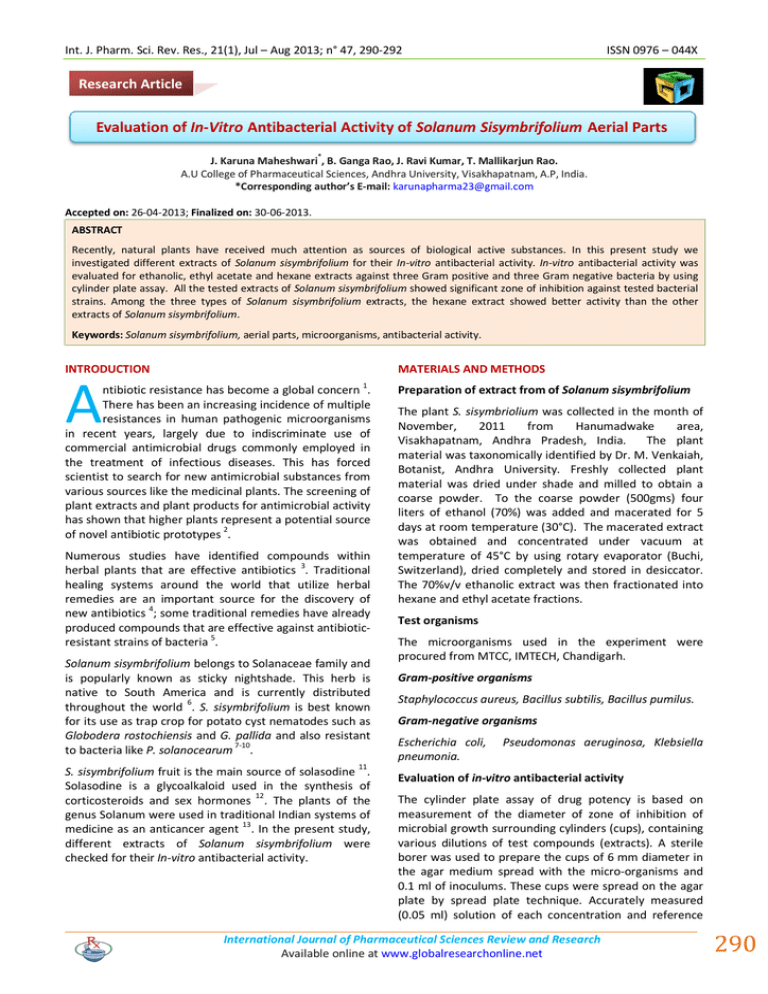
Int. J. Pharm. Sci. Rev. Res., 21(1), Jul – Aug 2013; n° 47, 290-292 ISSN 0976 – 044X Research Article Evaluation of In-Vitro Antibacterial Activity of Solanum Sisymbrifolium Aerial Parts * J. Karuna Maheshwari , B. Ganga Rao, J. Ravi Kumar, T. Mallikarjun Rao. A.U College of Pharmaceutical Sciences, Andhra University, Visakhapatnam, A.P, India. *Corresponding author’s E-mail: karunapharma23@gmail.com Accepted on: 26-04-2013; Finalized on: 30-06-2013. ABSTRACT Recently, natural plants have received much attention as sources of biological active substances. In this present study we investigated different extracts of Solanum sisymbrifolium for their In-vitro antibacterial activity. In-vitro antibacterial activity was evaluated for ethanolic, ethyl acetate and hexane extracts against three Gram positive and three Gram negative bacteria by using cylinder plate assay. All the tested extracts of Solanum sisymbrifolium showed significant zone of inhibition against tested bacterial strains. Among the three types of Solanum sisymbrifolium extracts, the hexane extract showed better activity than the other extracts of Solanum sisymbrifolium. Keywords: Solanum sisymbrifolium, aerial parts, microorganisms, antibacterial activity. INTRODUCTION MATERIALS AND METHODS A ntibiotic resistance has become a global concern 1. There has been an increasing incidence of multiple resistances in human pathogenic microorganisms in recent years, largely due to indiscriminate use of commercial antimicrobial drugs commonly employed in the treatment of infectious diseases. This has forced scientist to search for new antimicrobial substances from various sources like the medicinal plants. The screening of plant extracts and plant products for antimicrobial activity has shown that higher plants represent a potential source of novel antibiotic prototypes 2. Numerous studies have identified compounds within herbal plants that are effective antibiotics 3. Traditional healing systems around the world that utilize herbal remedies are an important source for the discovery of new antibiotics 4; some traditional remedies have already produced compounds that are effective against antibioticresistant strains of bacteria 5. Solanum sisymbrifolium belongs to Solanaceae family and is popularly known as sticky nightshade. This herb is native to South America and is currently distributed throughout the world 6. S. sisymbrifolium is best known for its use as trap crop for potato cyst nematodes such as Globodera rostochiensis and G. pallida and also resistant 7-10 to bacteria like P. solanocearum . Preparation of extract from of Solanum sisymbrifolium The plant S. sisymbriolium was collected in the month of November, 2011 from Hanumadwake area, Visakhapatnam, Andhra Pradesh, India. The plant material was taxonomically identified by Dr. M. Venkaiah, Botanist, Andhra University. Freshly collected plant material was dried under shade and milled to obtain a coarse powder. To the coarse powder (500gms) four liters of ethanol (70%) was added and macerated for 5 days at room temperature (30°C). The macerated extract was obtained and concentrated under vacuum at temperature of 45°C by using rotary evaporator (Buchi, Switzerland), dried completely and stored in desiccator. The 70%v/v ethanolic extract was then fractionated into hexane and ethyl acetate fractions. Test organisms The microorganisms used in the experiment were procured from MTCC, IMTECH, Chandigarh. Gram-positive organisms Staphylococcus aureus, Bacillus subtilis, Bacillus pumilus. Gram-negative organisms Escherichia coli, pneumonia. Pseudomonas aeruginosa, Klebsiella 11 S. sisymbrifolium fruit is the main source of solasodine . Solasodine is a glycoalkaloid used in the synthesis of corticosteroids and sex hormones 12. The plants of the genus Solanum were used in traditional Indian systems of medicine as an anticancer agent 13. In the present study, different extracts of Solanum sisymbrifolium were checked for their In-vitro antibacterial activity. Evaluation of in-vitro antibacterial activity The cylinder plate assay of drug potency is based on measurement of the diameter of zone of inhibition of microbial growth surrounding cylinders (cups), containing various dilutions of test compounds (extracts). A sterile borer was used to prepare the cups of 6 mm diameter in the agar medium spread with the micro-organisms and 0.1 ml of inoculums. These cups were spread on the agar plate by spread plate technique. Accurately measured (0.05 ml) solution of each concentration and reference International Journal of Pharmaceutical Sciences Review and Research Available online at www.globalresearchonline.net 290 Int. J. Pharm. Sci. Rev. Res., 21(1), Jul – Aug 2013; n° 47, 290-292 ISSN 0976 – 044X 15 standards were added to the cups with a micropipette. All the plates were kept in a refrigerator at 2 to 8°C for a period of 2 hours for effective diffusion of test compounds and standards. Later, they were incubated at 37°C for 24 hours. The presence of definite zone of inhibition of any size around the cup indicates antibacterial activity 14. the dose levels employed . Lack of activity can thus only be proven by using large doses16. Alternatively, if the active principle is present in high enough quantities, there could be other constituents exerting antagonistic effects 17 or negating the positive effects of the bioactive agents . With no antibacterial activity, extracts may be active against other bacterial species which were not tested 18. RESULTS CONCLUSION Evaluation of antibacterial activity All extracts exhibited antibacterial activity against tested bacterial strains in a dose dependent manner but relatively low activity when compared to that of standard Rifampicin. The activity may be higher if larger dose levels were employed. All extracts at concentrations of 50, 100, 200, 400µg/ml per cup exhibited antibacterial activity against tested bacterial strains in a dose dependent manner but relatively low activity when compared to that of standard Rifampicin. Ethanol extract showed best results against Bacillus subtilis and Staphylococcus aureus and no effect on E.coli and P.aeruginosa at lower concentrations. Ethyl acetate fraction showed best results against E.coli and K.pneumoniae. Hexane fraction showed best results against K.pneumoniae and B.pumilus. The results are shown in the Table 1. Table 1: Antibacterial activity of Solanum sisymbrifolium aerial parts extracts Acknowledgement: This work was financially supported by the University Grants Commission (Grant No.F (II)/M.Pharmacy/2010-12) for the foundation project of M.Pharmacy. The authors were also thankful to College of Pharmaceutical Sciences, Andhra University for providing the facilities to carry out the present research work. REFERENCES 1. Westh H, Zinn CS, Rosdahl VT, Sarisa Study Group: An international multicenter study of antimicrobial consumption and resistance in Staphylococcus aureus isolates from 15 hospitals in 14 countries, Microbial Drug Resistance, 10, 2004, 169-176. 2. Afolayan AJ, Extracts from the shoots of Arctotis artotoides inhibit the growth of bacteria and fungi, Pharm. Biol, 41, 2003, 22-25. 3. Basile A, Sorbo S, Giordano S, Ricciardi L, Ferrara S, Montesano D, et al., Antibacterial and allelopathic activity of extract from Castanea sativa leaves, Fitoterapia, 71, 2000, 110-116. 4. Okpekon T, Yolou S, Gleye C, Roblot F, Loiseau P, Bories C, et al., Antiparasitic activities of medicinal plants used in Ivory Coast, J. Ethnopharmacol, 90, 2004, 91-97. 5. Kone WM, Kamanzi Atindehou K, Terreaux C, Hostettmann K, Traore D, Dosso M, Traditional medicine in North Coted’Ivoire screening of 50 medicinal plants for antibacterial activity, J. Ethnopharmacol, 93, 2004, 43-49. 6. Chakravarty AK, Mukhopadhyay S, Saha S, Pakrashi SC, A neolignan and sterols in fruits of Solanum sisymbriifolium, Phytochemistry, 41, 1996, 935-939. 7. Been TH, Schomaker CH, Development and evaluation of sampling methods for fields with infestation foci of potato cyst nematodes (Globodera rostochiensis and G. pallida). Phytopathology, 90, 2000, 647-656. 8. Hill MP, Hulley PE, Aspects of the phenology and ecology of the South American weed, Solanum sisymbriifolium, in the Eastern Cape Province of South Africa. African Plant Protection, 6, 2000, 53-59. 9. Tjou-Tam-Sin NNA, Janse JD. Research on the ecology of Ralstonia (Pseudomonas) solanacearum. Symptomless infection of Solanum sisymbriifolium by Ralstonia solanecearum race 3, biovar 2 (Smith) Yabuuchi et al. In: Annual Report 2000. Diagnostic Activities Plant Protection Service, Wageningen, The Netherlands. 2001, 41-44. # Plant material Zone of inhibition (diameter in mm) Dose (µg/cup) gram (+) ve gram (–) ve B.s S.a B.p E.c P.a K.p 50 08 09 07 - - 07 100 10 10 08 07 07 08 200 13 12 09 09 08 10 400 15 13 10 11 10 12 50 10 11 08 08 08 14 100 08 10 08 12 09 15 200 11 09 09 14 10 16 400 13 11 10 15 10 16 50 12 10 12 09 09 09 100 13 10 13 10 10 09 200 11 11 10 11 10 12 400 11 10 09 11 11 13 50 24 22 19 19 24 28 DMSO - - - - - - Water - - - - - - Ethanol extract Ethyl acetate extract Hexane extract Rifampicin S.a=Staphylococcus aureus; E.c=Escherichia coli; P.a=Pseudomonas aeruginosa; B.s = Bacillus subtilis, B.p= Bacillus pumilus; K.p = Klebsiella pneumoniae. -=No activity; #Values are the average of triplicate; Includes the cup diameter (6mm). DISCUSSION Ethanol extract did not show any effect on E.coli and P.aeruginosa at lower concentrations. Negative results do not mean absence of bioactive constituents nor is that the plant inactive. Active compound(s) may be present in insufficient quantities in the extracts to show activity with International Journal of Pharmaceutical Sciences Review and Research Available online at www.globalresearchonline.net 291 Int. J. Pharm. Sci. Rev. Res., 21(1), Jul – Aug 2013; n° 47, 290-292 10. Turner SJ, Fleming CC, Multiple selection of potato cyst nematode Globodera pallida virulence on a range of potato species. I. Serial selection on Solanum-hybrids. European Journal of Plant Pathology, 108, 2002, 461-467. ISSN 0976 – 044X 15. Taylor JLS, Rabe T, McGraw LJ, Jager AK, Van Staden J, Towards the scientific validation of traditional medicinal plants, Plant Growth Regul, 34, 2001, 23-37. 11. Chauhan K, Sheth N, Ranpariya V, Parmar S, Anticonvulsant activity of solasodine isolated from Solanum sisymbriifolium fruits in rodents, Pharm Biol, 49(2), 2011, 194-199. 16. Farnsworth NR, Biological approaches to the screening and evaluation of natural products. In: Rasoanaivo P, Ratsimamanga-Urverg S (Eds) Biological Evaluation of Plants with Reference to the Malagasy Flora, Madagascar, 1993, 35-43. 12. Biren Shah N, Seth AK, Textbook of Pharmacognosy and Phytochemistry, First Edition, Elsevier, New Delhi, 2010, 273. 17. Jager AK, Hutchings A, Van Staden J, Screening of Zulu medicinal plants for prostaglandin synthesis inhibitors, J. Ethnopharmacol, 52, 1996, 95-100. 13. Krishnan marg KS. A text book- The useful plants of India, First Edition, PID, CSIR publication, New Delhi, 1992, 572. 18. Shale TL, Strik WA, Van Staden J, Screening of plants used by southern African traditional healers in the treatment of dysmenorrhoea for prostaglandin-synthesis inhibitors and uterine relaxing activity, J. Ethnopharmacol, 64, 1999, 9-14. 14. Pharmacopoeia of India (Indian Pharmacopoeia) Fourth Edition, Vol 1, The Controller of Publications, New Delhi, 1996, A100–A124. Source of Support: Nil, Conflict of Interest: None. International Journal of Pharmaceutical Sciences Review and Research Available online at www.globalresearchonline.net 292
